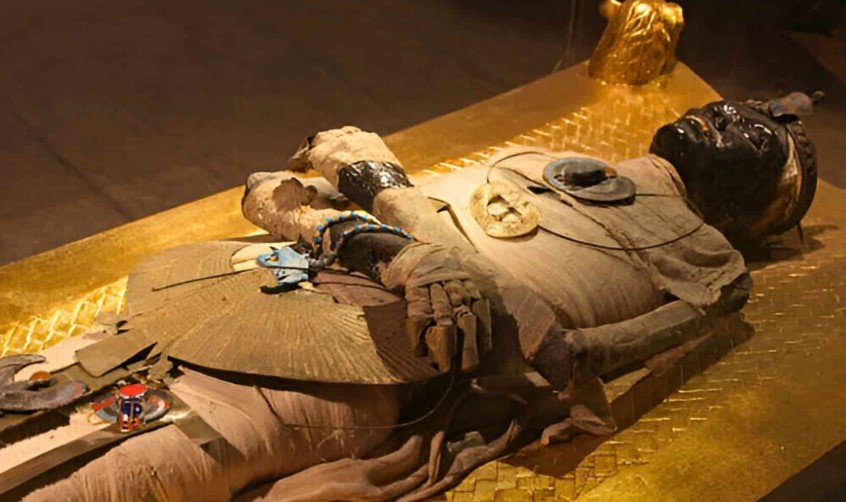A 4,500-year-old skeleton is now rewriting the script on how one of history’s most iconic civilisations may have risen — not in isolation, but through ancient cross-cultural mingling across thousands of kilometres.
The man’s bones, pulled from the Nile Valley and recently analysed by geneticists, are offering up secrets that stone inscriptions and tomb murals couldn’t.
A Potter’s Bones, a World’s Connection
The skeleton belonged to a man who lived in what’s now southern Egypt, probably worked with his hands — maybe spinning clay into pots — and died around age 60. But what really caught scientists off guard wasn’t just his age or profession. It was his DNA.
Roughly 20% of his genetic material appears to trace back to Mesopotamia — modern-day Iraq — suggesting that people, not just pottery or grain, were on the move between these two ancient centres of civilisation.
That changes a lot.
“We always suspected there was contact between these regions,” said Prof. Pontus Skoglund of the Francis Crick Institute in London, who led the study. “But this is the first biological proof we’ve had that people actually made those long-distance journeys and contributed to the communities they settled in.”
More Than Just Trade: A Transfer of Ideas and Genes
Cultural exchange between Egypt and Mesopotamia isn’t a new theory. Archaeologists have long noted parallels in early scripts, architectural techniques, and agriculture. But now there’s biological evidence to go along with the material stuff.

This particular individual, whose remains were recovered from an elite burial site near Aswan, was found with signs of wear on his bones typical of a potter’s repetitive movements. His grave goods were modest, but his bones have given him a posthumous promotion of sorts: from anonymous worker to possible witness to a major era of human development.
And the implications are bigger than one man.
-
DNA shows clear markers of Mesopotamian ancestry, a region over 1,500km away
-
Suggests migration or intermarriage between peoples of both regions
-
Aligns with known trade routes but points to deeper integration
“It’s like finding a fingerprint at a crime scene,” said an archaeologist not involved in the study. “You knew someone had been there — now you know who.”
What the DNA Is Telling Us Now
So how did this Mesopotamian ancestry show up? Was it through one parent? A grandparent? Or just traces in a larger population that slowly moved westward?
The researchers aren’t sure yet. DNA from ancient bones is notoriously fragile and hard to read, especially in hot, dry regions like Egypt. But thanks to improved sequencing techniques, the team was able to reconstruct enough of the man’s genome to find those telltale genetic markers.
“There’s a whole story in this one person,” Prof. Skoglund said. “And he’s probably not the only one.”
There’s reason to believe that Egypt’s ancient population — particularly in the early dynastic period — was more genetically diverse than previously thought. That diversity might’ve played a role in how quickly Egyptian society went from scattered villages to pyramid-builders.
A Skeleton Brings History Into Focus
The research has sparked renewed interest in the idea that Egypt’s transformation wasn’t an internal revolution, but the result of outside influences blending with local traditions.
At Liverpool John Moores University, where part of the skeletal reconstruction was done, researchers used 3D modelling and wear analysis to determine that the man worked for decades with his hands. His joints were heavily worn. His spine curved from years of bending. A craftsman. Possibly poor. But now, ironically, he’s shaping history.
The man was missing part of his right arm and several fingers and toes — perhaps from burial conditions, or maybe from life-long injuries. Whatever the case, he was buried with care.
Just one sentence here.
And then comes the twist: despite his humble role, he carries a genetic passport from one of the world’s oldest civilisations.
What Happens Next?
The researchers say this is just the beginning. If DNA like this can be extracted from other ancient Egyptians — especially those buried near key trade routes or port cities — the pattern might grow clearer.
“We’re now looking at several other skeletons from the same period,” Skoglund said. “We want to know if this was a one-off or part of a broader trend.”
The challenge now is finding enough well-preserved samples. Egypt’s desert climate preserves bones fairly well, but humidity and contamination can still mess up results. It’s like trying to read a book after it’s been through a sandstorm and a flood.
Still, the possibilities are tantalising. Egypt and Mesopotamia have long stood as rival centres of early human innovation — agriculture, writing, religion, bureaucracy. To find that their people mixed and moved, loved and lived across those supposed boundaries? That kind of shatters the old textbook narrative.
Here’s a quick table showing what we know so far about the ancient man:
| Feature | Details |
|---|---|
| Estimated Age at Death | ~60 years old |
| Occupation (Probable) | Potter (based on skeletal wear) |
| Location Found | Southern Egypt, near Aswan |
| DNA Origin | 20% Mesopotamian ancestry |
| Burial Site | Modest grave in elite cemetery |
| Physical Condition | Missing lower right arm, worn joints |
A Link That Was Always There
Some historians had long argued that cultural links between Egypt and Mesopotamia were just that — cultural. This new research says otherwise.
It’s now possible that ancient Egyptian society was shaped, in part, by the movement of people from distant lands who brought their genes, their traditions, and maybe even their gods with them.
That’s not just a historical footnote. It’s a reminder of how interconnected humanity has always been — even when building pyramids.
